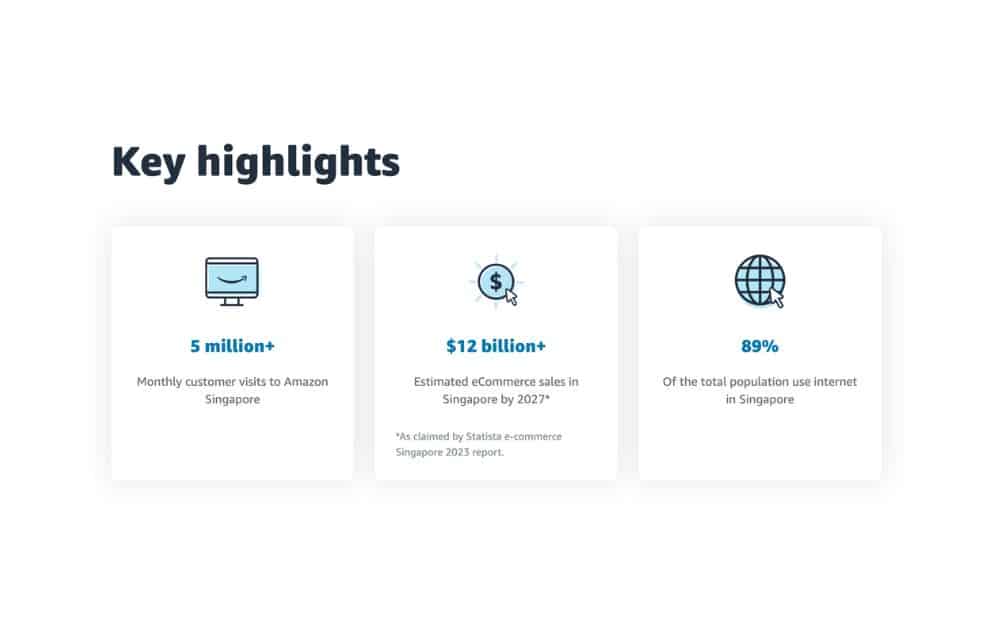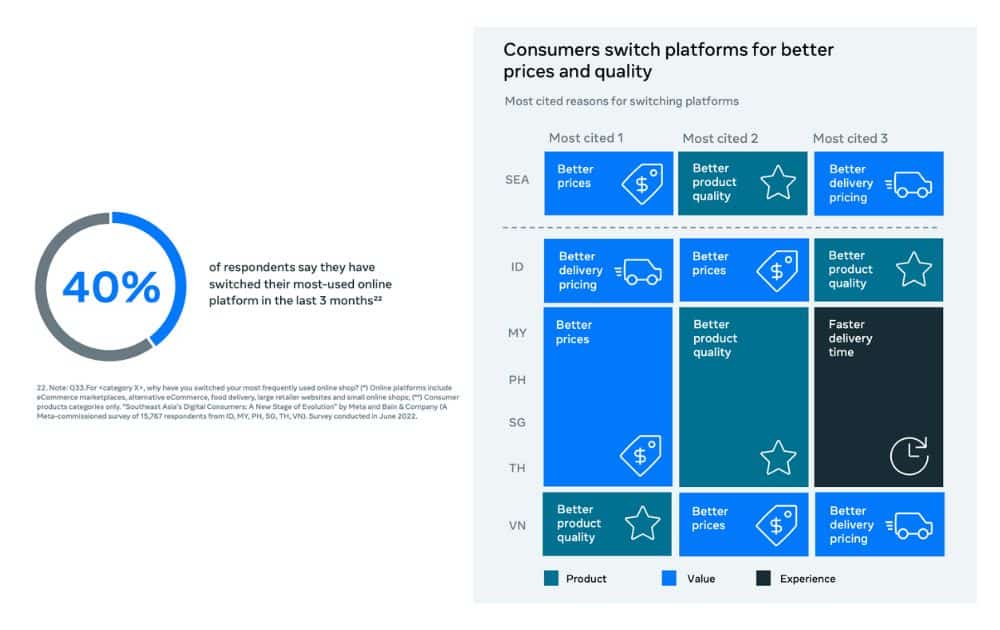The Singapore eCommerce landscape offers unparalleled opportunities for sellers to tap into a rapidly expanding market.
Many entrepreneurs and retailers focus on this vibrant city-state, a thriving hub of innovation and economic prowess. Brands are drawn to the Lion City due to its strategic location, tech-savvy population, and progressive business environment.
With its position as a gateway to Asian markets, Singapore has become a key player in the eCommerce revolution.
Let’s uncover the layers of the Singapore eCommerce ecosystem. Below, we explore what fuels its growth, the nuances of this burgeoning landscape, and the unique opportunities it presents for sellers.
Is Ecommerce Growing in Singapore?
Here are a few quick overview of the state of eCommerce in Singapore:
- According to Statista’s July 2022 data, Singapore boasted the second-highest internet penetration rate in Southeast Asia.
- Around 5.18 million individuals out of Singapore’s total population are active internet users.
- Gaming sites, online shopping platforms, content sharing, and social media are lucrative venues in the context of the digital-native market.
- 93% of internet users in Singapore engage with the internet for personal purposes on a daily basis. Users spend an average of about 7.3 hours online.
- The city-state features robust protection against cyber-attacks and data breaches to safeguard its substantial internet user population.
- Preference for online shopping in Singapore is on a steady rise, per the findings from Meta’s 2021 SYNC Southeast Asia. The proportion of participants who prefer “mostly online” shopping has surged from 35% in 2020 to 53% in 2021.

Given the information above, it can’t be denied that doing eCommerce in Singapore offers a blend of innovation, challenges, and opportunities.
Its tech-savvy population, coupled with the city-state’s unwavering commitment to digital security, sets the stage for continued growth and exploration.
How Big is Ecommerce in Singapore?
From the vibrant streets of Orchard Road to the virtual aisles of online marketplaces, Singapore provides a diverse array of avenues for sellers to establish their digital presence.
The Singapore eCommerce market revenue projections reached an impressive US$5.84 billion in 2023. Additionally, its anticipated annual growth rate is at 11.70%, from 2023 to 2027.
So, it’s clear that the city-state’s eCommerce ecosystem promises to catalyze unparalleled growth and prosperity.
Moreover, insights from Mordor Intelligence state that Singapore’s eCommerce market was valued at USD 5.21 billion in 2022. Projections forecast a compound annual growth rate (CAGR) of 11.00%, culminating in an estimated value of USD 9.58 billion within five years.

As the Singapore eCommerce market flourishes, forecasters expect the user base to reach 4.3 million by 2027. On the other hand, user penetration, currently at 61.2%, is set to skyrocket to 70.2% by the same year.
Amid these projections, the true allure of the Singapore eCommerce landscape lies in its average revenue per user (ARPU). The Lion City’s ARPU is projected to reach USD1.59k, which underscores the purchasing power of the Singaporean consumer.
In effect, this data also indicates the boundless potential of a market that values quality, innovation, and convenience.
Singapore Ecommerce Export Opportunities
The US International Trade Administration (ITA) says the Singaporean eCommerce sector achieved a gross merchandise volume totaling US$7.1 billion in 2021. Furthermore, projections indicate an escalation to US$9.8 billion by the year 2025.
Consumer electronics exhibited remarkable prominence, amassing a market volume of US$655 million in 2021. Other noteworthy product categories encompassed diverse sectors:
- Fashion
- Culinary items
- Cosmetics
- Personal care
- Furniture
- Appliances
- Toys
Shipping to Singapore
Foreign sellers may find it easier to penetrate the Singapore eCommerce market compared to other countries.
According to the ITA, Singapore hosts numerous local fulfillment centers that offer comprehensive, end-to-end managed eCommerce solutions. These fulfillment centers include:
- uParcel
- iStoreiSend
- ezyCommerce
- Allsome
- WhiteBox
- SP eCommerce
Nestled at the crossroads of global shipping and air routes, Singapore holds a strategic position in Southeast Asia’s transportation and communication landscape.
The Lion City’s Changi Airport is also a pivotal aviation hub in the Asia Pacific region, with over 100 airlines servicing approximately 300 cities.
Furthermore, Singapore is a preeminent international maritime center, fostering connections with 600 ports across more than 120 countries.
Bolstered by a well-established logistics network and infrastructure, Singapore has garnered the attention of major global logistics entities, including industry giants such as FedEx, UPS and DHL.
These influential players have chosen Singapore as the site for their significant hubs, a testament to the city-state’s reputation as a logistics powerhouse.
Related content: Remote Fulfillment vs Marketplace Expansion
Requirements for exporting to Singapore
In terms of taxes, the city-state grants a Goods and Services Tax (GTS) relief to air-imported items, as per Singapore’s Customs website. This is applicable to all products except for intoxicating liquors and tobacco, as long as the total Cost, Insurance, and Freight (CIF) value remains below SGD 400–or around USD 296.
Note, however, that this relief does not apply to goods imported by other modes of transport, such as sea freight or land unless specified otherwise.
Due to these benefits, Singaporeans can enjoy a fair range of duty-free import products. The tax GST relief offers a great incentive to foreign sellers.
An international seller looking to penetrate the Singapore eCommerce landscape can also take advantage of smooth deliveries by partnering with local distributors. The catch, however, is the need to register as a local entity or work with an IOR (Importer of Record). This approach will also enable you to fulfill same-day orders.
Selling on Amazon Singapore
Though Amazon Singapore was only launched in 2019, it has already been making its mark in the city-state. In fact, the marketplace’s internal data says Amazon Singapore gets over five million visits per month.

Here are a few 2022 customer trends from Amazon Singapore that signal upward growth:
- Consistent Expansion. Ecommerce sectors experiencing steady growth, establishing a post-pandemic baseline driven by enduring habits and emerging trends.
- Rapid Surge. Ecommerce categories display remarkable acceleration during the pandemic and retain growth potential due to unexplored demand.
- Shifting Dynamics. Ecommerce segments witnessing elevated digitalization trends that bolstered sales amid the pandemic, yet facing potential fluctuations in 2022 due to external factors like remote work, vaccinated travel opportunities or achieving a novel baseline.
Sellers interested in entering the Singapore eCommerce landscape must not only learn how to sell on Amazon Singapore, but also what items to sell to make good profits.
As per Internal Amazon Singapore data, 2021 customer trends include:
- Smart living. Robot vacuum cleaners, smart gardens, laptops, wireless, and phone accessories
- Wellness and self-care. Massage equipment, supplements, fitness watches, diffusers, and facial products)
- Home entertainment. Video games, board games, gaming devices, and books)
Global selling on Amazon provides entrepreneurs with access to a vast array of seller tools. One great example is Amazon FBA. Brands can use Amazon’s logistics machine to pick, pack, ship, and deliver products on time.
The retail giant has also launched its IP Accelerator program in Singapore, which aims to help local businesses protect their brands from trademark infringements.
Customer Satisfaction at the Core of Singapore Ecommerce
Meta’s 2022 SYNC Southeast Asia says 40% of respondents changed their most-used online platform in the last three months before the survey. In Singapore, the most cited reason for switching was better prices, followed by better product quality and faster delivery time.

The order of reasons for switching online platforms was the same for Singapore’s neighboring countries – Malaysia, Philippines, and Thailand.
Given this data, it’s crucial for Singapore eCommerce sellers to prioritize competitive pricing while offering high-quality products and efficient fulfillment.
Looking Ahead
Whether you choose to do it on your own or with the help of a global expansion partner, setting up shop in Singapore will open the gates to the Southeast Asian market.
As we navigate the Singapore eCommerce landscape, it becomes evident that success in this vibrant ecosystem requires more than just tapping into its digital infrastructure and logistics prowess.
Success in Singapore calls for an understanding of the local consumer’s preferences, a keen eye on emerging trends, and a proactive approach to adapting to evolving regulations.
Authors

Esteban Muñoz is an SEO copywriter at AMZ Advisers, with several years’ experience in digital marketing and e-commerce. He’s been able to achieve incredible growth on the Amazon platform for their clients by optimizing and managing their accounts and creating in-depth content marketing strategies.

Carla Bauto Deña is a journalist and content writer producing stories for traditional and digital media. She believes in empowering small businesses with the help of innovative solutions, such as e-commerce, digital marketing, and data analytics.



